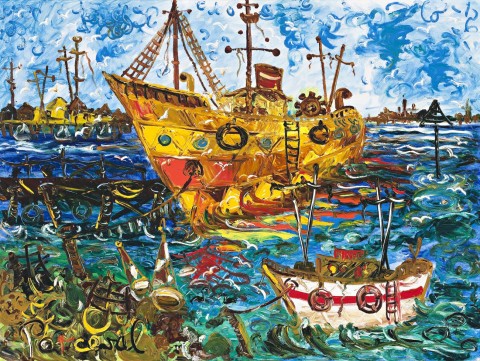THE OLD BOAT AT PORT MELBOURNE
JOHN PERCEVAL
oil on canvas
91.5 x 122.0 cm
signed lower left: Perceval
signed and inscribed with title verso: The Old Boat / at / Port Melbourne / Perceval
Private collection
Leonard Joel, Melbourne, 23 August 1995, lot 154
Private collection, Sydney
The Beautiful Seagulls at Port Melbourne, c.1985, oil on canvas, 59.5 x 75.0 cm, private collection
John Perceval was the youngest member of the celebrated ‘Angry Penguins’, a group of artists centred around patrons John and Sunday Reed in the 1940s. Through their combined efforts, Australian art underwent a revolution and the various members are rightly recognised as some of this country’s most significant creators. Perceval’s influence was also critical, with his ground-breaking ceramics known collectively as ‘The Angels’ – ‘one of the most important one-man shows held in Australia since the war’1 – and his extended series of paintings based around Melbourne’s working port at Williamstown. The Old Boat at Port Melbourne is from late in the artist’s career when Perceval emerged from years of troubled isolation with a renewed sense of purpose, creating paintings full of exuberant energy and joyous, juicy paint.
Perceval was a child prodigy who developed his nascent skills whilst stricken with polio as a schoolboy. His meeting with Arthur Boyd in 1940 is recognised as one of the pivotal moments in the history of Australian art and the two companions were inseparable over the next decades as they encouraged each other’s skills and training, eventually opening a pottery business together in 1944. Whereas Boyd used his art as a vehicle to interrogate his personal demons, Perceval developed his own distinctive style of impasto paint marks, often applied alla prima (wet-on-wet), peopled with bustling characters inspired by the paintings of Flemish artists such as the Brueghel family. In the early 1950s, he and Charles Blackman started exploring Williamstown, a still-functioning but run-down port, home to worn out tugs, rust buckets, leaking fuel and birdlife. It was these battered relics that captured Perceval’s eye and in 1956, his paintings of the location became the inaugural exhibition for the newly opened Australian Galleries. He revisited the location for subsequent series in 1959, and again in 1967 – 68, but by the early 1970s, the artist’s heavy reliance of alcohol and good living took its toll, leading to his self-admission into the Larundel psychiatric hostel in 1977.
Following a revelatory exhibition of new drawings in 1981 and a well-received Retrospective at Heide in 1983, Perceval’s confidence slowly returned and, with the help of assistants, started to re-engage with painting, and with his beloved waterfront. The Old Boat at Port Melbourne features one of his favorite motifs from the late 1980s and early 1990s, a disheveled ancient tug-boat moored close to the shore. It is a painting about weather as much as it is about the vessel, with scattered clouds buffeting through a windy sky, kicking up waves in their wake; and the salty tang is palpable. Audiences were dazzled by the result of Perceval’s revitalized spirit with old colleague Albert Tucker commenting that the paintings were ‘a marvellous assertion of his identity, a principle of affirmation against the destructive forces in life’.2 More accolades followed including his award of an Officer of the Order of Australia in 1990 and shortly before his death, the sale of one of his second-series Williamstown paintings from the famed Mertz Collection set the record for a living Australian artist.3
1. Smith, B., ‘The Antipodean Artists’, The Critic as Advocate: selected essays 1948-1988, Oxford University Press, Melbourne, 1989, p. 146
2. Tucker, A., 1988, cited in John Perceval, exhibition catalogue, BMG Fine Art, Sydney, 1989
3. Scudding Swans, 1959, Christie’s, Melbourne, 28 June 2000
ANDREW GAYNOR
